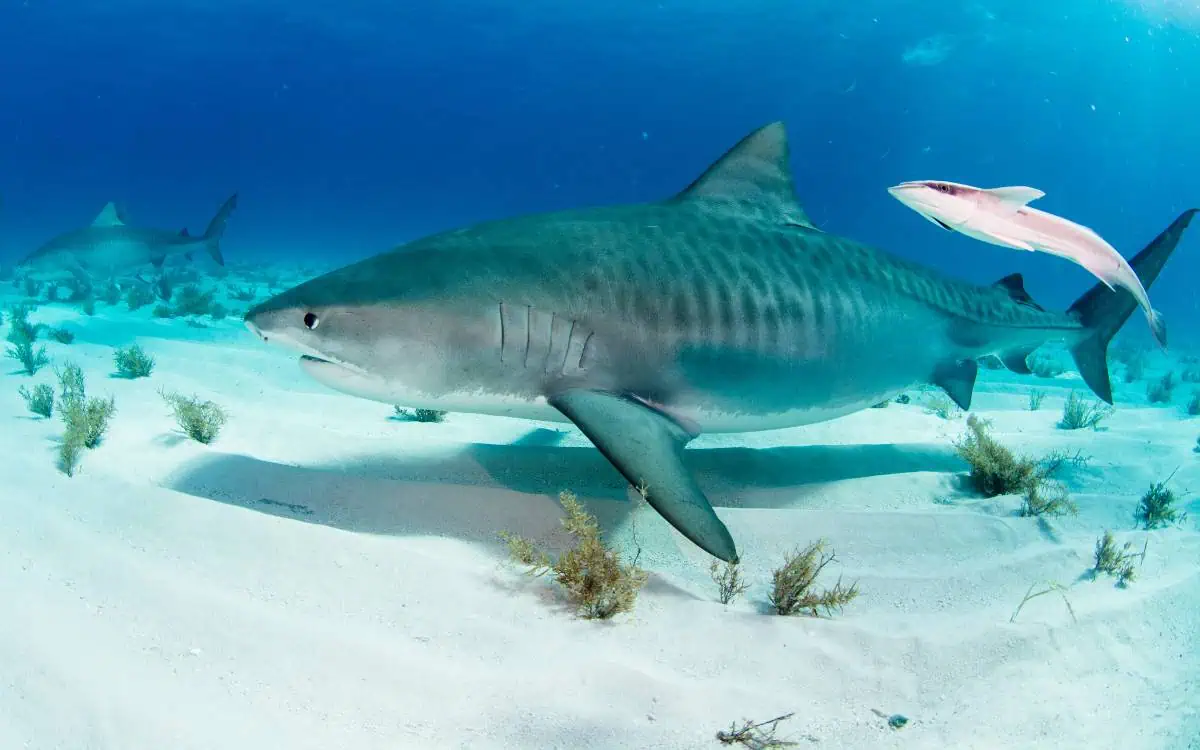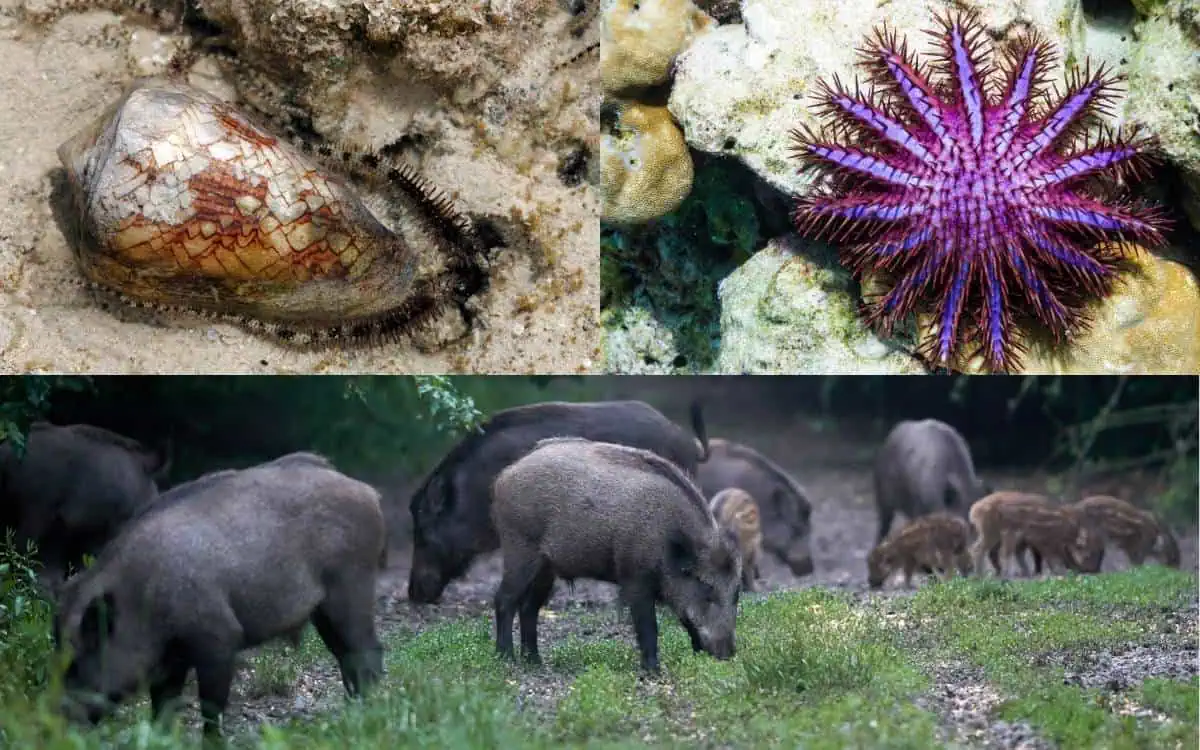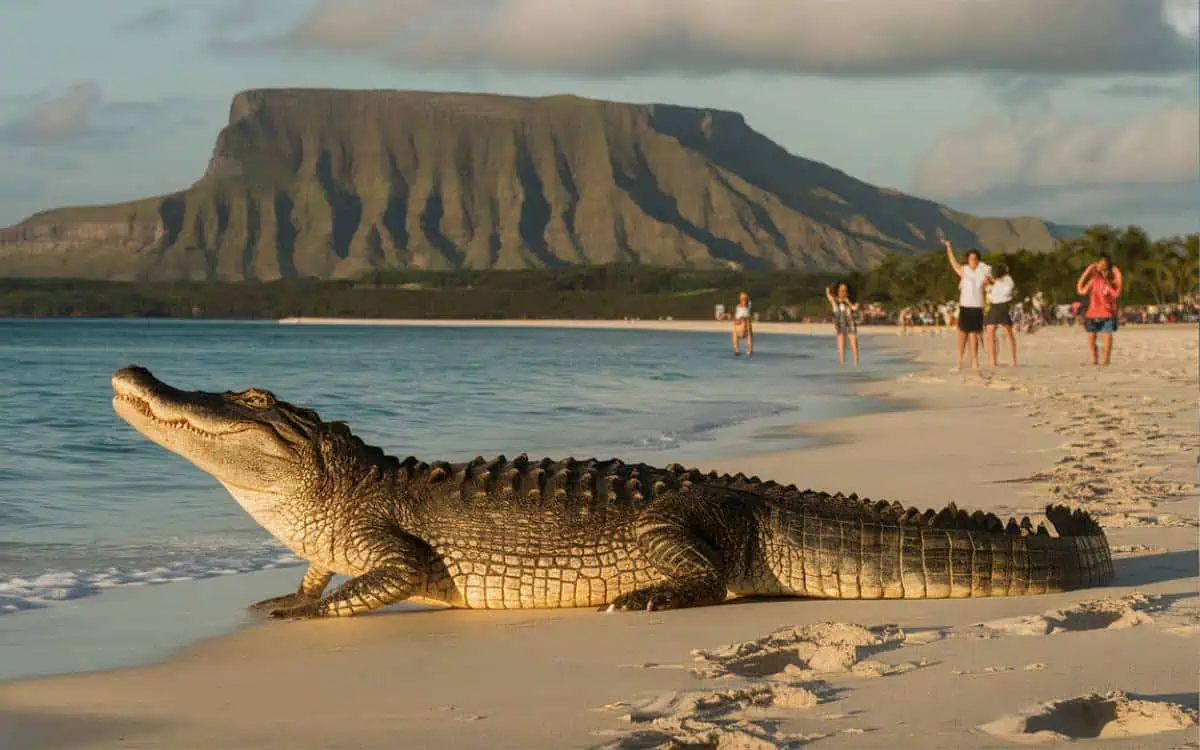Top 9 Dangerous Animals in Hawaii: Keeping You Safe While in Hawaii

Are you planning a trip to Hawaii and wondering about the dangerous animals you might encounter?
While Hawaii is a beautiful paradise, it’s also home to some creatures that can pose risks to visitors and residents alike.
From venomous spiders and giant centipedes on land to dangerous marine creatures like box jellyfish and tiger sharks in the ocean, it’s important to stay informed.
Are There Dangerous Wild Animals in Hawaii?
Evidence & Metrics
| Metric | Value | Source |
|---|---|---|
| Native land predators | 0 species | Hawaii DLNR |
| Venomous snake species | 0 (illegal) | University of Hawaii |
| Box jellyfish peak days | 8-10 after full moon | Hawaii Ocean Project |
| Ocean drowning incidents (annual avg) | 60-80 cases | Hawaii Dept of Health |
| Centipede species (venomous) | 1 primary (Scolopendra) | UH College of Tropical Agriculture |
Reviewed: November 2025
This dangerous animals in Hawaii post is written by Bryan Murphy, an expert in Hawaii travel and a top-rated podcast host. The post may contain affiliate links, meaning I may earn a small commission if you use the provided links. Learn more on my privacy policy page.
Planning Your Trip? Use Our Favorite Resources!
✈️ Flights: For the cheapest flights, we use Skyscanner
🚗 Rental Car: We recommend Discount Hawaii Car Rental
🌋 Attractions: We recommend Get Your Guide
🌺 Luaus and Tours: We recommend Hawaii Tours
📱 Mobile Tour App: Our favorite is Shaka Guide
This post will cover the top nine dangerous animals in Hawaii, providing you with essential safety tips to ensure your Hawaiian adventure remains enjoyable and safe. Let’s explore what you need to know to keep yourself protected.
Key Takeaways of Dangerous Animals in Hawaii
- Brown recluse spiders, found in Hawaii, can cause serious symptoms like pain, vomiting, and dizziness with their bites. They often hide in woodpiles or crevices around homes and gardens.
- Giant Scolopendra centipedes are venomous creatures that can grow up to 12 inches long. Their bites cause extreme pain and swelling.
- Box jellyfish have toxic venom that causes severe reactions such as difficulty breathing and muscle weakness. In January 2023 alone, there were 156 reported stings on Oahu’s beaches.
- Cone snails hide near coral reefs and have potent venom that may lead to anaphylactic shock. Always wear water shoes when swimming around reefs to avoid accidental stings.
- Feral pigs are aggressive animals with sharp tusks that pose threats both to humans and native Hawaiian species. Keep a safe distance if you encounter one while exploring the islands.
No time to read? Listen to our audio overview of dangerous animals in Hawaii
Land-Based Threats

Watch out for some creepy crawlers on Hawaii’s land. These tiny creatures can cause big problems if you get too close!
1. Brown Recluse Spider
The brown recluse spider is one of the most dangerous animals in Hawaii. It has markings on its back that look like a violin, making it easy to identify.
Though not very aggressive, its bite can cause serious problems like pain, vomiting, and dizziness.
Other spiders in Hawaii include the black widow spider and cane spider. A brown recluse bite might also lead to headaches and swelling if not treated quickly. Always check places where they might hide, such as woodpiles or crevices around your home and garden areas.
2. Giant Scolopendra Centipede
Giant Scolopendra Centipedes are not to be taken lightly. These venomous creatures can grow up to 12 inches long! Often found exploring for food at night, they avoid the sun’s harsh rays.
Their bites cause extreme pain and swelling, sometimes described as agonizing, especially if bitten on fingers or toes.
Letting one of these centipedes bite you is something you definitely don’t want to happen during your Hawaiian vacation. The redness around the bite area can last a while too.
So, watch out when moving rocks or trekking through dense vegetation—or even in your hotel room! It is definitely one of the most dangerous animals in Hawaii.
3. Little Fire Ants
Little fire ants, originally from Central and South America, have become invasive pests in Hawaii. These tiny creatures measure just 1/16 of an inch but pack a powerful sting.
Their stings can cause welts and irritation for several weeks, making them one of the most dangerous animals in Hawaii.
Infestations are often discovered when people experience an “ant shower,” where numerous ants fall from trees or plants above. You might encounter these ants during hikes or even in your backyard.
Keep an eye out and take precautions to avoid their painful bites!
Ocean Risks

Hawaii’s waters can be breathtaking but watch out for some dangerous creatures. Whether you are swimming or snorkeling, always stay alert and respect the marine life around you.
4. Tiger Sharks
Tiger sharks prowl Hawaiian waters and grow up to 13 feet long. You can spot them by the bars on their flanks and blunt noses. These shark species are particularly dangerous, though they have only caused 11 fatal attacks in Hawaii since 1828.
Shark bites often happen more in November and December, so extra caution is crucial during these months.
You may see tiger sharks near the shores of Oahu or other popular beaches. Swimmers should be careful, especially at dusk when these predators come closer to land. Lifeguards often post warnings if there is an increased risk of shark presence.
Always watch for signs and stay within designated safe areas while enjoying your swim or snorkel adventure in this tropical paradise!
5. Box Jellyfish
Box jellyfish have toxic venom that can cause serious harm. These marine animals are often found near south-facing beaches in Hawaii, especially about 8-10 days after the full moon.
On January 16, 2023, there were 156 reported stings by box jellyfish in Oahu alone. Hawaii is also home to various other aquatic threats.
Getting stung by a box jellyfish can lead to difficulty breathing, shock, swelling, muscle weakness, and hives. To avoid them, steer clear of certain areas during their peak times.
Always pay attention to posted warnings on beaches and be cautious while swimming or snorkeling in Hawaiian waters.
6. Yellow-bellied Sea Snake
Watch out for the yellow-bellied sea snake while swimming in Hawaii’s waters. This snake has highly potent neurotoxic venom, which can be deadly. They prefer the open ocean but might occasionally drift closer to shore.
They are timid and rarely bite humans, so you usually don’t have to worry unless provoked.
Spotting one of these sea snakes might be rare, yet caution is crucial if you do see one. Their distinctive yellow belly makes them easily identifiable against the blue ocean water.
Though they’re not aggressive toward humans, avoiding any interaction with this venomous creature is best for your safety.
Additional Hazards

Hawaii has more wild animals that can pose risks… you might want to be careful!
7. Cone Snails
Cone snails hide in Hawaiian waters and have over 30 different types. The Banded Marble Cone Snail is one of the most dangerous animals in Hawaii, with venom that can cause anaphylactic shock.
These tiny creatures look harmless but deliver a powerful sting, so don’t pick them up! If stung by one, scrub the area well—most cases only need cleaning.
Severe symptoms may require medical attention.
Swimming near coral reefs ups your chances of spotting these snails. They blend in with colorful corals and sea urchins, making them hard to see.
Always wear water shoes and be cautious around rocky shorelines on any Hawaiian beach or Waikiki Beach specifically to avoid stepping on sharp spines or unusual marine creatures like cone snails.
8. Crown-of-thorns Starfish
The crown-of-thorns starfish threatens Hawaii’s marine ecosystem. These creatures devour coral reefs, damaging the vibrant underwater world. Divers trained in removing these starfish help keep Hawaii’s reefs healthy.
Their spikes are dangerous and can cause a venomous sting that leads to persistent bleeding, swelling, and vomiting. If you plan to snorkel or dive, stay cautious around these starfish.
Seek medical help immediately if stung by one of these venomous creatures in Hawaiian waters.
9. Feral Pigs
Feral pigs, also known as wild boars, roam the Hawaiian Islands. They can become aggressive if they feel threatened or need to protect their piglets. Their sharp tusks can cause severe injuries, so it’s crucial to keep a safe distance.
These large animals pose threats not only to humans but also to native species and vegetation. Feral pigs are responsible for habitat loss and spread diseases across wetlands and forests.
If you spot one while exploring Kauai or other areas, stay calm and move away slowly—always respect their space!
Are There Alligators in Hawaii?

Not a real picture. A silly, imaginative image of what an alligator would look like in Hawaii.
No, there are no alligators in Hawaii. Hawaii is entirely free from alligators and crocodiles. The islands’ isolation and strict regulations ensure that these large reptiles are not part of Hawaii’s diverse ecosystems.
Unlike places such as south Florida, where alligators and crocodiles are common, Hawaii has preserved its unique wildlife composition without these potentially dangerous animals.
Protecting Hawaii’s Ecosystem
Hawaii’s commitment to preserving its natural world is evident through its stringent regulations against invasive species.
The absence of alligators and crocodiles underscores the importance of these measures in maintaining the delicate balance of the islands’ ecosystems.
Our Opinions and Advice
As someone who loves visiting Hawaii, I want to share some advice: don’t worry too much about the dangerous animals, but stay informed.
Hawaii is a stunning place with so much to offer, and being aware of potential risks ensures you can enjoy your trip safely.
Learn about creatures like the brown recluse spider, giant centipede, and box jellyfish so you know what to look out for. Shark attacks in Hawaii are rare, but it’s always a good idea to follow local guidelines and swim in designated areas.
By staying informed and cautious, you can have a fantastic and worry-free adventure in this tropical paradise. Aloha!
Dangerous Animals in Hawaii Wrap-Up
Hawaii is a beautiful destination, but it is also home to several dangerous animals that visitors should be aware of.
From the brown recluse spider with its venomous bite to the giant centipede and the stings of box jellyfish, it’s crucial to stay informed and cautious.
While exploring the islands, keep an eye out for scorpions in Hawaii, and be cautious around coral reefs to avoid encounters with cone snails. Remember that shark attacks in Hawaii are rare, but it’s always best to heed local warnings and swim in designated areas.
If you’re planning your trip to Hawaii, be sure to take the necessary precautions to stay safe. For more information on Hawaii’s wildlife and tips for snorkeling in Hawaii, check out our related articles on the best snorkeling spots and safety tips for beachgoers.
Hawaii is a paradise worth exploring, but being aware of these dangers ensures a safe and enjoyable trip. Aloha!
Enjoyed this Post About Dangerous Animals in Hawaii? (Pin it to save it!)

FAQs for Dangerous Animals in Hawaii
1. Are there dangerous animals in Hawaii?
Yes, Hawaii is home to a variety of dangerous animals including venomous creatures like eels, scorpions, sea urchins, and the giant centipede.
2. What should I be cautious of while snorkeling in Hawaii?
While snorkeling in Hawaii, be aware of potentially dangerous aquatic species such as eels and bull sharks. However, shark attacks are rare in Hawaii.
3. How can I stay safe from dangerous animals in Hawaii?
To stay safe from dangerous animals in Hawaii, avoid touching or approaching any unfamiliar creatures, especially ones with sharp teeth or poisonous tentacles.
4. Are there any venomous spiders in Hawaii?
Yes, Hawaii is home to venomous spiders such as the brown violin spider and the brown widow spider. If bitten, seek medical attention immediately as venomous spider bites can be dangerous if left untreated.
5. What should I do if I encounter a dangerous animal in Hawaii?
If you encounter a dangerous animal in Hawaii, such as an eel or scorpion, slowly back away and do not make any sudden movements to avoid provoking them.
6. Are there alligators in Hawaii?
No, alligators are not native to Hawaii. If you do spot an alligator, it may be an escaped pet, and you should notify local authorities immediately.
7. Are there any invasive species in Hawaii that pose a threat?
Yes, Hawaii has invasive species like the brown tree snake and the lesser brown scorpion, which can be harmful to the local ecosystem and potentially dangerous to humans.
RELATED POSTS
Hawaii In November – Is November A Good Time to Visit Hawaii? (2025)
[dssb_sharing_buttons icon_placement="icon" columns="2" _builder_version="4.27.0" _module_preset="default"...
Unforgettable Things to Do in Hawaii with Teens (They’ll Actually Love!)
[dssb_sharing_buttons icon_placement="icon" columns="2" _builder_version="4.24.3" _module_preset="default" box_shadow_style_icon="preset1"...
Why You Can’t Travel Between Hawaii’s Islands by Boat
Love the Podcast? Join as a member for FREE!This post may contain affiliate links, meaning I earn a small commission if you use the links. View our...
Bryan Murphy, owner of Hawaii’s Best Travel, is a certified Hawaii destination expert from the Hawaii Visitors Bureau. He actively participates in the Hawaii Visitors and Convention Bureau as a member and has a strong educational background focused on local culture and sustainability. As the host of "Hawaii’s Best Travel," a top-30 US travel podcast, Bryan combines his years of experience with valuable insights. He connects with a broad online community, reaching nearly half a million people, and offers a richer, more responsible way to experience Hawaii.








